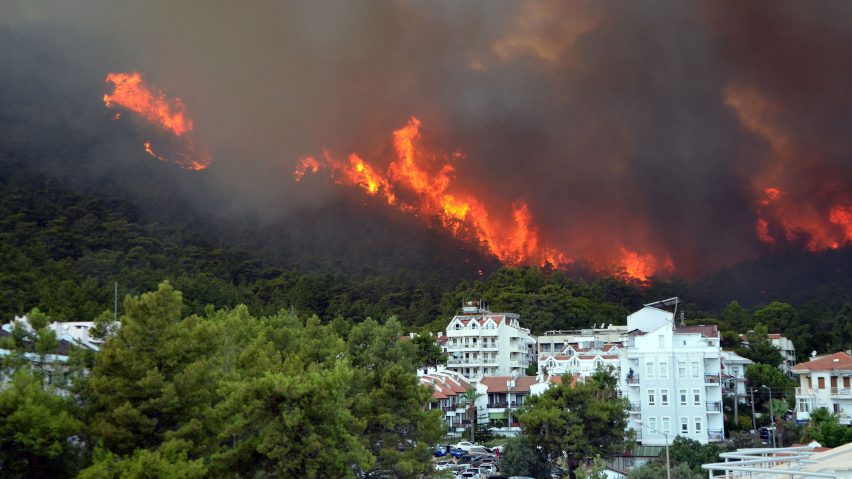The latest IPCC climate report offers a "nugget of hope" but architects and designers must "make changes to the way they design" to help avert catastrophic climate change, according to Architects Climate Action Network and other UK climate pressure groups.
The report should "act as a propellant to their efforts to decarbonise," said Joe Giddings of ACAN, while design collective URGE said it "should make designers completely rethink our idea of success".
Architects Declare said "we need rapid system change" to avert disaster.
Every tonne of emissions makes a difference
Released on Monday in preparation for November's COP26 summit, the landmark report found that limiting global warming to the crucial 1.5-degree threshold set out in the Paris Agreement is now virtually impossible.
But the report also outlines that "immediate, rapid and large-scale" cuts to greenhouse gas emissions could still help to stabilise global temperatures around this threshold.
This would dramatically reduce the frequency and intensity of extreme weather events, compared to a warming of two degrees or more above pre-industrial levels.
The built environment, which is responsible for around 40 per cent of greenhouse gas emissions, will have its own dedicated day at the COP26 conference, where signatories of the 2015 Paris Agreement will convene to decide their course of action based on the latest data.
"The message was clear from the IPCC," ACAN's Giddings told Dezeen. "Every single tonne of carbon dioxide emissions that we prevent helps to lessen the impact of human-induced climate change and the extreme weather events it causes."
"For architects designing new buildings that are often responsible for a tonne of CO2 per square meter of construction, this nugget of hope from the scientists should act as a propellant to their efforts to decarbonise," he added.
"I hope this motivates architects to really make changes to the way they design. Everything you draw, every choice you make matters."
Design needs to be regenerative, carbon-negative and disaster resistant
Sophie Thomas, co-founder of environmental creative collective URGE, argued that "design needs to shift completely" in the face of the new data. "Old models don't apply now unless we are all happy to be part of the problem," she said.
"We need to urgently get to the point where everything we do is delivering a net positive impact," added URGE co-founder Michael Pawlyn.
"I think the latest climate science should make designers completely rethink our idea of success. What would it mean to be successful in perpetuating a system that will destroy the future for billions of people?"
Climate change action group Architects Declare argues that this would need to go hand in hand with regulatory measures imposed at a government level.
"A world in which humanity can flourish within planetary boundaries is still possible and within reach but we need rapid system change if we are to achieve this," architect Andrew Waugh said on behalf of the collective.
"Today, we call once again on our government to engage with us in meaningful dialogue about how we can collectively rise to this challenge."
Assael Architecture director Rory O'Hagan argued that the data should inspire architects to create buildings that are resilient to climate change without further contributing to it.
"The report's findings serve as a call to arms to ensure that the sustainable buildings we design are resilient and flexible in the face of ever more volatile weather patterns," he said.
"Recent flash floods in the UK, China and Germany and extreme heat fatalities in Australia and Canada, exacerbated by heat-absorbing surfaces and poor ventilation, have exposed the critical vulnerability of building unprepared for the climate crisis."
1.5 degrees of warming will bring "irreversible" changes
The UN's Intergovernmental Panel on Climate Change (IPCC) is the world's leading authority on climate change and its first report since 2013 is based on the expertise of more than 200 scientists and thousands of peer-reviewed studies collated over the last eight years.
The report, which was released as wildfires burned around the world, concluded that global temperatures have already risen by 1.1 degrees Celsius compared to pre-industrial levels. This is "unequivocally" a result of man-made greenhouse gas emissions, it states, as concentrations of CO2 in the atmosphere have reached their highest level in two million years.
It also forecasts five possible scenarios based on different levels of future emissions, all of which result in 1.5 degrees of warming or more by 2040, smashing the Paris Agreement goals.
This will lead to "irreversible" changes in sea levels and extreme weather events such as heatwaves, putting "billions of people at immediate risk" according to UN secretary general António Guterres.
While the IPCC's worst-case scenario predicts global warming of up to 5.7 degrees by the end of the century, the report also found that "strong and sustained" emissions reductions and carbon dioxide removal from the atmosphere could help to stabilise temperatures at between one to 1.8 degrees.
This would help to stave off the most dramatic effects of climate change, as every additional 0.5 degrees of warming drastically increases the frequency and intensity of extreme weather events.
Carbon removal could present a solution
A further two ICPP reports, which are set to be published next year, will look more closely at the impacts of climate change and its potential solutions.
But the latest report has already suggested that if carbon removal technologies were scaled up to sequester more CO2 from the atmosphere than is emitted by human activity, this could help to lower global temperatures and ocean acidification while having a positive impact on biodiversity as well as food and water supplies.
Ways of removing carbon from the atmosphere and creating net-zero buildings and products were explored in Dezeen’s recent carbon revolution series.
These include direct air capture as pioneered by companies like Climeworks as well as natural processes such as mineral carbonation, which can be harnessed in the creation of paint, fertiliser and concrete masonry units.

